How to Assess If You Can Eat Chicken Bit by a Raccoon
Consuming chicken bitten by a raccoon is strongly discouraged due to grave health risks. Raccoon bites can transmit diseases such as rabies, leptospirosis, and various zoonotic pathogens like Salmonella, which can cause severe illness in humans.
Chickens bitten by raccoons may also harbor infections and parasites such as Baylisascaris procyonis, presenting neurological risks if ingested. Due to these potential threats, affected chickens should be isolated and thoroughly examined by a veterinarian.
Proper disposal and rigorous sanitation practices are essential to mitigate cross-contamination risks. Understanding these risks and preventative measures can greatly enhance food safety and animal health.
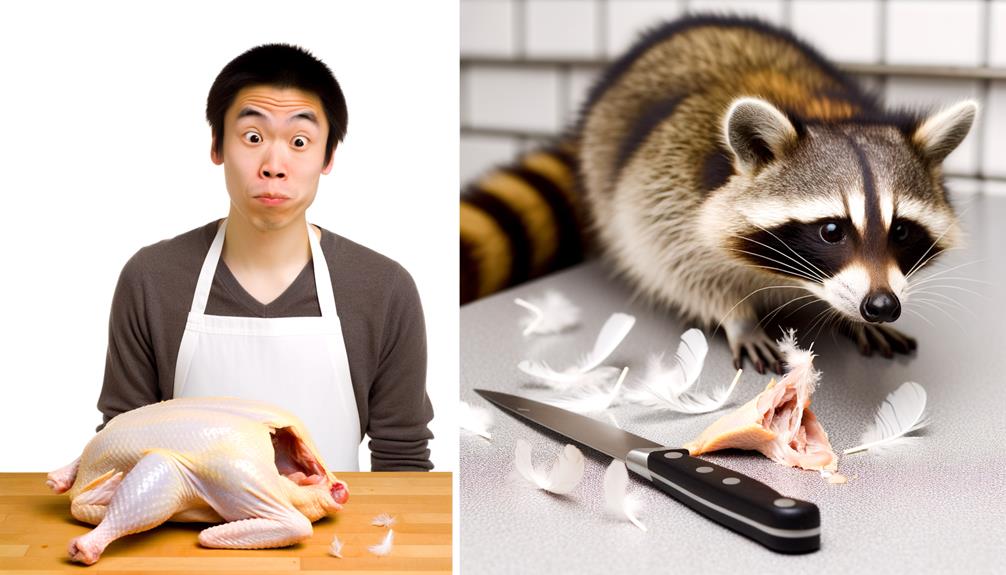
Key Takeaways
- Risk of Disease Transmission: Eating a raccoon-bitten chicken risks contracting diseases like rabies, leptospirosis, and Salmonella.
- Potential Infection: Raccoon bites may cause infections, making the chicken unsafe to consume.
- Consult a Veterinarian: Seek veterinary advice to assess the chicken's health and potential risks before deciding to consume.
- Biohazard Disposal: Proper disposal of a raccoon-bitten chicken is recommended to prevent health hazards.
- Food Safety: Consuming compromised poultry poses significant food safety risks; it is better to err on the side of caution.
Understanding Raccoon-Borne Diseases
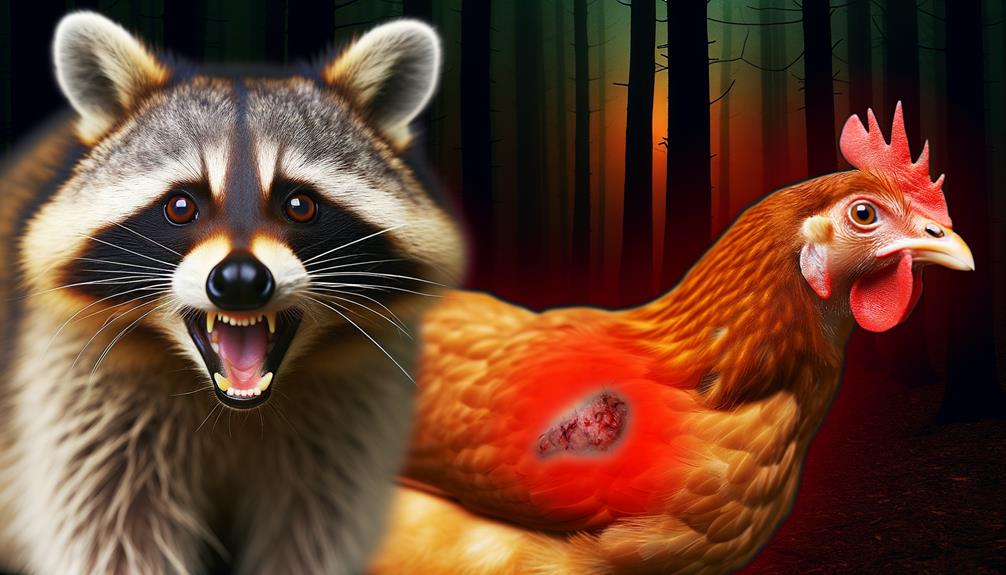
Raccoons are known carriers of various pathogens, including bacteria, viruses, and parasites, which can pose significant health risks to humans. Notably, raccoons can transmit diseases such as rabies, leptospirosis, and raccoon roundworm (Baylisascaris procyonis). Rabies, a viral disease affecting the nervous system, is almost invariably fatal once symptoms appear.
Leptospirosis, caused by Leptospira bacteria, can lead to severe kidney and liver damage. Baylisascaris procyonis, a parasitic roundworm, can cause serious neurological damage if ingested. Additionally, raccoons may carry Salmonella and other zoonotic pathogens that can cause gastroenteritis.
Given the diverse array of pathogens raccoons harbor, understanding these risks is vital for preventing transmission and ensuring public health safety, particularly in situations involving potential contamination of food sources.
Chickens and Disease Transmission
Chickens that have been bitten by raccoons face significant risks of disease transmission, including bacterial infections such as Salmonella and viral infections like Avian Influenza.
Implementing strict preventative measures, such as proper quarantine protocols and vaccination programs, is essential for safeguarding poultry health.
Understanding the dynamics of interspecies disease transmission can inform effective strategies to mitigate these risks and guarantee food safety.
Disease Transmission Risks
The interaction between raccoons and chickens can result in the transmission of various zoonotic diseases, posing significant health risks to both poultry and humans.
Raccoons can carry pathogens such as Salmonella, Leptospira, and the rabies virus, which can be transmitted through bites or saliva. When a chicken is bitten by a raccoon, these pathogens may enter the chicken's bloodstream, potentially leading to systemic infections.
The risk extends to humans who may consume the infected poultry or come into contact with contaminated surfaces. Symptoms in infected chickens can range from mild illness to severe, sometimes fatal conditions, thereby necessitating caution.
Understanding these risks highlights the importance of monitoring and managing the health of poultry exposed to wild animals.
Preventative Measures for Chickens
Implementing robust biosecurity measures is essential to mitigate the risk of disease transmission from raccoons to chickens. Key strategies include secure housing and fencing to prevent raccoon access, regular health monitoring, and prompt isolation of injured or ill birds.
Vaccination programs targeting common pathogens, such as avian influenza and Newcastle disease, enhance flock immunity. Additionally, maintaining cleanliness by removing food remnants and waste reduces attractants for raccoons.
Surveillance systems, such as motion-activated cameras, can provide early warnings of raccoon activity. Personal protective equipment (PPE) for handlers, along with stringent sanitation protocols, further minimizes cross-contamination risks.
Educating farm personnel on disease prevention and early recognition of symptoms is vital for maintaining poultry health and ensuring safe consumption.
Identifying Raccoon Bite Marks
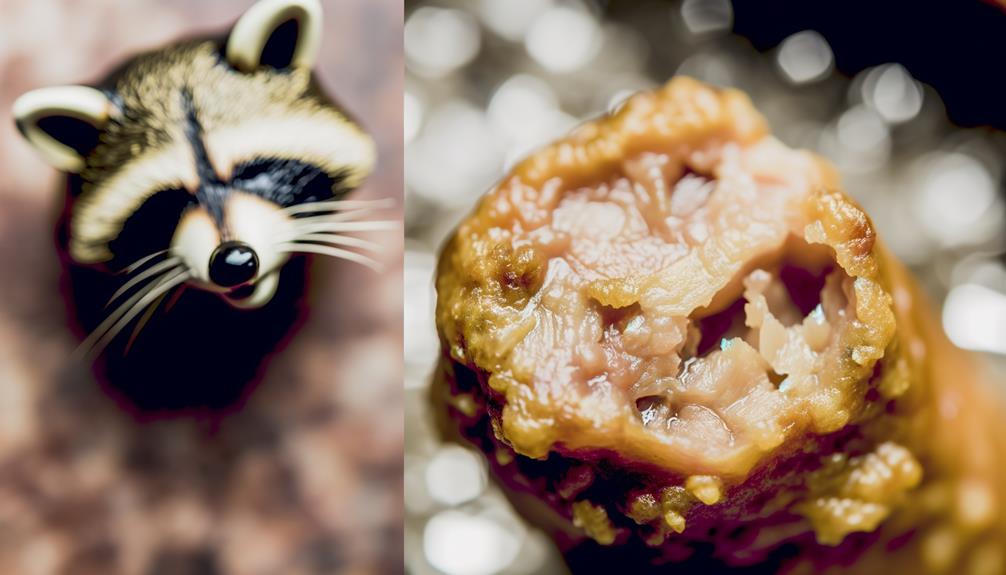
Identifying raccoon bite marks on chickens involves recognizing specific puncture wounds typically characterized by paired, evenly spaced holes.
These wounds may exhibit signs of infection, including swelling, redness, and discharge, which can complicate the health of the affected chicken.
Proper identification and understanding of these symptoms are critical for timely intervention and treatment.
Recognizing Puncture Wounds
Puncture wounds caused by raccoon bites can be identified by their distinct spacing and depth, often presenting as paired punctures due to the animal's sharp canine teeth. These punctures are typically about a centimeter apart, reflecting the raccoon's dental structure.
The wounds usually penetrate deeply, given the strength and sharpness of the raccoon's teeth, which are adept at breaking through skin and muscle. Observing the wound's edges is essential; they are often clean-cut, lacking the tearing seen with other types of animal bites.
Additionally, there may be smaller, less deep punctures from the raccoon's other teeth. Recognizing these specific characteristics aids in accurately identifying raccoon bites, which is vital for appropriate medical and safety measures.
Signs of Infection
After recognizing the distinct puncture wounds caused by raccoon bites, it is vital to monitor for signs of infection, which can develop rapidly and pose significant health risks. Early indicators include localized swelling, redness, and warmth around the bite area.
Additionally, the presence of pus, unusual discharge, or an offensive odor may signal bacterial contamination. Systemic symptoms such as fever, lethargy, or loss of appetite in the chicken further suggest a progressing infection.
It is essential to act promptly by isolating the affected chicken and seeking veterinary intervention to prevent the spread of pathogens. Ignoring these signs can lead to severe complications, including septicemia, which can jeopardize the entire flock's health.
Assessing Chicken Health Post-Bite
To accurately evaluate the health of a chicken following a raccoon bite, it is important to conduct a detailed physical examination, paying particular attention to signs of infection, trauma, and stress. The assessment should include a thorough inspection of the bite area, monitoring for swelling, redness, and discharge. It is critical to check for fever, changes in behavior, and appetite alterations. Additionally, palpate for any underlying fractures or soft tissue damage.
| Health Aspect | Signs to Observe | Importance |
|---|---|---|
| Infection | Redness, swelling, discharge | Indicates bacterial presence |
| Trauma | Bruising, lacerations, fractures | Assesses physical damage |
| Stress | Behavioral changes, reduced appetite | Reflects overall well-being |
Prompt veterinary consultation is advisable for a thorough evaluation.
Risks of Consuming Bitten Chicken
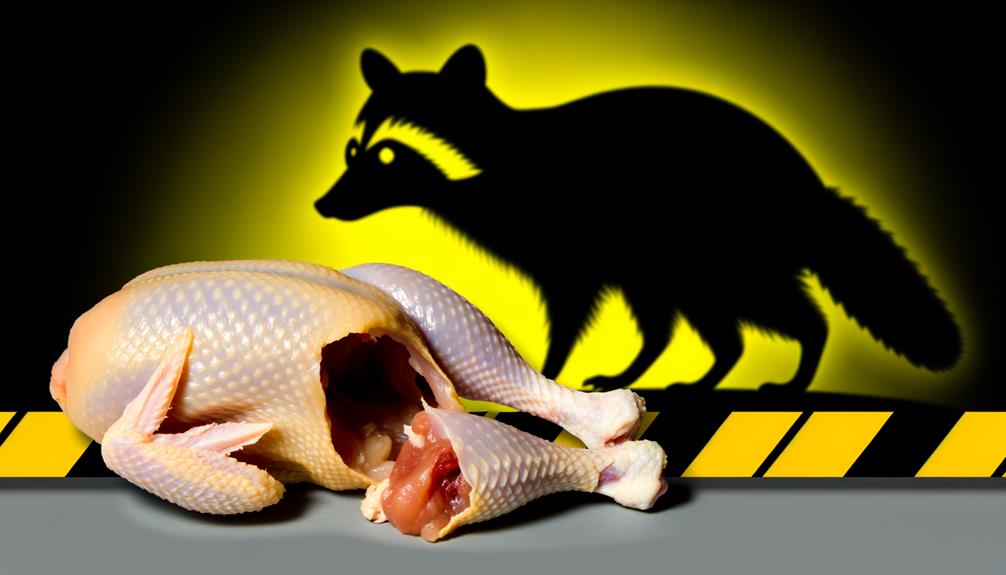
Consuming chicken that has been bitten by a raccoon poses significant health risks due to the potential transmission of zoonotic pathogens, such as rabies and bacterial infections. These risks arise from the direct contact of the raccoon's saliva with the chicken's tissue, which can introduce harmful microorganisms.
Key concerns include:
- Rabies: A fatal viral infection affecting the nervous system, rabies can be transmitted through raccoon bites.
- Leptospirosis: This bacterial disease can lead to severe kidney and liver damage.
- Salmonella: Raccoons can carry Salmonella, causing gastrointestinal distress in humans.
- Campylobacteriosis: Another bacterial infection leading to severe digestive issues.
These pathogens underscore the substantial risks associated with consuming chicken subjected to raccoon bites, warranting extreme caution.
Immediate Steps After a Raccoon Bite
Upon discovering that a chicken has been bitten by a raccoon, immediate actions are important to mitigate potential health hazards. The first step is to isolate the affected chicken to prevent further contamination. Next, wearing gloves, carefully inspect the wound and clean it with antiseptic solution. It is crucial to monitor for signs of infection or unusual behavior. Additionally, proper documentation of the incident, including the date, time, and observed symptoms, is crucial for subsequent evaluation. Ensure the coop is thoroughly cleaned and disinfected to eliminate any remaining pathogens.
| Step | Action | Purpose |
|---|---|---|
| 1 | Isolate the chicken | Prevent contamination |
| 2 | Inspect and clean wound | Reduce infection risk |
| 3 | Monitor for signs of infection | Early detection of complications |
| 4 | Document incident details | Facilitate further evaluation and treatment |
When to Consult a Veterinarian
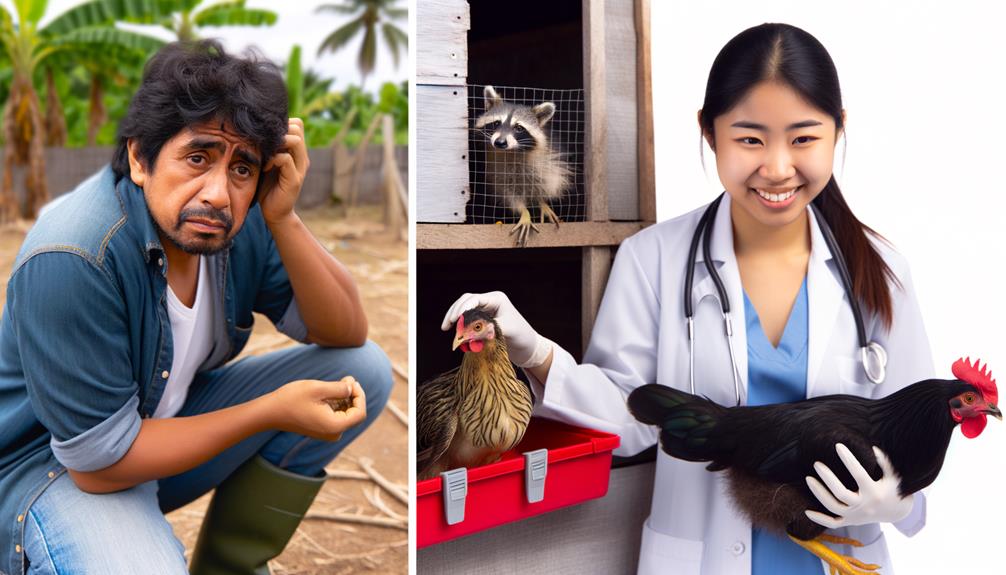
Regularly seeking advice from a veterinarian is essential when a chicken is bitten by a raccoon to guarantee proper medical assessment and treatment. Veterinary intervention is necessary to mitigate the risks of disease transmission and secondary infections. Here are four key reasons to seek advice from a veterinarian:
- Disease Identification: Raccoons can transmit diseases like rabies and avian influenza, requiring professional diagnosis.
- Wound Management: Veterinarians can provide appropriate wound cleaning, suturing, and antibiotics to prevent severe infections.
- Vaccination Guidance: They can advise on necessary vaccinations to protect other poultry and livestock.
- Health Monitoring: Continuous health monitoring ensures the affected chicken's recovery and prevents potential outbreaks within the flock.
Seeking advice from a veterinarian ensures thorough care and maintains overall flock health.
Proper Disposal of Affected Chicken
Proper disposal of a chicken bitten by a raccoon is crucial to prevent the spread of zoonotic diseases and maintain biosecurity within the poultry farm. Initially, the affected chicken should be isolated from the flock to minimize contamination risks.
The carcass should be handled with gloves and placed in a double-layered, heavy-duty plastic bag to prevent leakage. Securely tie the bag and transport it to a designated biohazard disposal facility or follow local regulations for animal waste incineration.
If incineration is not feasible, deep burial at a minimum depth of three feet, away from water sources, is recommended. Thoroughly disinfect all equipment and surfaces that came into contact with the affected chicken to guarantee complete decontamination.
Preventing Future Wildlife Attacks

Implementing robust biosecurity measures is essential to prevent future wildlife attacks on poultry farms. These measures not only protect the health of the poultry but also ensure the safety of the food supply chain.
Key strategies to mitigate wildlife threats include:
- Secure Enclosures: Reinforce poultry housing with durable materials to prevent entry by raccoons and other predators.
- Regular Inspections: Conduct frequent checks for any signs of breaches or weaknesses in the enclosures.
- Sanitation Protocols: Maintain cleanliness around the farm to avoid attracting wildlife through food scraps or waste.
- Exclusion Barriers: Install additional fencing or netting around the perimeter to create a secondary layer of defense.
Implementing these practices can notably reduce the risk of wildlife-related incidents.
Conclusion
To sum up, the consumption of chicken bitten by a raccoon presents significant health risks due to potential zoonotic diseases. The invisible threat of pathogens such as rabies and leptospirosis underscores the necessity of vigilant evaluation and appropriate action.
By meticulously following guidelines for identifying bite marks, evaluating chicken health, and consulting veterinary professionals, the safety of both humans and livestock can be safeguarded.
Consequently, the specter of disease transmission looms large, compelling rigorous preventive measures and responsible disposal practices.






